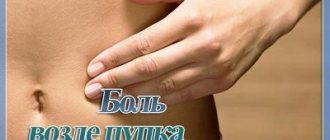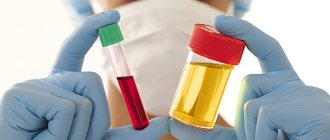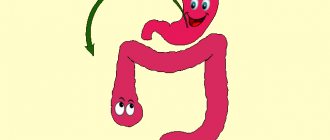Number of views: 98 746
Last update date: 16.02.2022
Average reading time: 4 minutes
Diarrhea is called frequent, loose stools. This condition may be accompanied by bloating (flatulence) due to the accumulation of gases in the digestive system. The reason for this is excessive gas formation in the intestines or insufficient removal of gases to the outside. Even in the absence of any abnormalities, the gastrointestinal tract contains a certain amount of gas. It is formed during the life of intestinal microflora and during the neutralization of gastric juice and normally does not cause discomfort to a person, gradually leaving naturally.
Mechanisms in normal and pathological conditions
Let us immediately note that rumbling in the stomach and diarrhea may not be related to each other. Everyone knows the reaction of the intestines when you feel hungry. And diarrhea, for example, occurs in women during menstruation.
Rumbling is caused by increased formation of gases and their movement along the intestinal tube.
Irritation of the small intestine and increased peristalsis in the large intestine lead to accelerated movement of contents and cause diarrhea. Gas bubbles are able to move upward, entering the stomach; they are manifested by belching. If exit in both directions is difficult, then bloating (flatulence) is observed.
Normal sources of gases are air entering the stomach and the digestion process. Swallowing air - during eating, smoking, chewing gum, a little air enters the stomach (aerophagia), most of it is removed with belching. This reason is especially relevant for people who snack in a hurry and drink sparkling water.
A smaller part enters the small intestine, where it is absorbed into the blood or reaches the colon and is excreted naturally. Gastric gas contains oxygen, nitrogen and carbon dioxide. Belching has no odor. The appearance of an unpleasant odor during belching indicates indigestion and is a reason to consult a doctor.
Formation during normal digestion - in nature, there are substances that the human body is not able to digest if supplied with food. Some types of sugars and complex carbohydrates (cellulose, lignin, pectins, chitin) pass into feces and form its basis.
However, during transit through the intestines, microorganisms try to act with their enzyme systems, since these substances are suitable for their nutrition. At the same time, as a result of breakdown, proteins and fats are found in the intestines.
It is important to note which foods cause bloating and bubbling.
A biochemical interaction occurs with the formation of hydrogen, carbon dioxide, and in 1/3 of people, for unclear reasons, methane is synthesized. Intestinal gases are absorbed into the bloodstream in a small volume, the main part is excreted through the rectum.
Some consider difficulties in draining feces to be a sign of the formation of methane; feces remain on the surface of the water for a long time. Since the composition of the microflora in the intestines of different people differs, the causes of seething and the degree of gas formation are determined by the individual characteristics of food digestion.
An important point in the functioning of the intestines is the guidance of the nervous system. Against the background of an intact mucous membrane, hyperactive contractions can occur during anxiety and fear. The stomach begins to gurgle and suddenly feels the urge to go to the toilet.
The connection with the nervous system explains why the intestines are seething during “bear sickness” in students before taking exams.
With pathology of the digestive organs, the secretion of enzymes of the stomach, pancreas, and the flow of bile are disrupted, and dysbacteriosis is formed. Seething in the stomach and diarrhea do not occur easily due to increased gas formation, but due to the loss of the intestines’ ability to properly digest food. Symptoms become constant. They cannot be stopped without the intervention of therapy.
Infection and gurgling in the abdomen
Dysentery causes stomach turmoil.
Intestinal infections are quite common, especially in the warm season.
This is due to the increased activity of pathogens that can penetrate the human digestive tract. In most cases, the pathological condition develops against the background of:
- Salmonellosis. By consuming milk, meat and poultry eggs of sick animals, the onset of the disease can be diagnosed. In addition to the seething in the abdomen, when this disease develops, the patient’s body temperature rises, flatulence, diarrhea, and vomiting appear. To avoid the emergence of an infectious process with rather unpleasant symptoms, it is necessary to purchase food products only in trusted stores. Before eating foods, they must be properly processed at high temperatures.
- Dysentery. The bacterium is transmitted through water, food or feces of sick people. The disease occurs as a result of the dysentery bacillus entering the body. The disease is characterized by intoxication of the body and weakness. It is quite dangerous in childhood and old age. When dysentery appears, a person’s temperature rises, turbulence in the stomach and diarrhea appear. Feces are characterized by a mucous consistency. Dysentery occurs as a result of poor personal hygiene.
- Intestinal viruses. The disease is accompanied by seething in the abdomen, liquid stool, and bloating. A sick person may show signs of an acute respiratory disease in the form of inflammation of the tonsils, cough, and runny nose. Transmission of viruses occurs through the fecal-oral or airborne route.
- Botulism. The onset of the disease is observed during the period of penetration of the spore-forming bacillus into the body. During the course of the infectious process, a strong poison is formed, which has a negative effect on the performance of the nervous system. The pathological condition is accompanied by gases, bloating, seething, gases, pale skin, paralysis, and blurred vision. The occurrence of the disease can be diagnosed against the background of eating meat products, fish, mushrooms, or home canned food.
- Cholera. It is a fairly dangerous infectious process that causes epidemics. The disease is characterized by immediate spread. The infection is accompanied by severe diarrhea, vomiting, muscle cramps, severe dehydration, and small folds in the skin. During the course of the infectious process, the patient's body temperature does not increase. The source of infection is a sick person.
There are a large number of infectious processes that negatively affect the functioning of the digestive tract. This is why there is rumbling in the stomach, which is accompanied by diarrhea.
What foods cause bubbling?
Gas formation is affected more by carbohydrate foods, fats and proteins - to a lesser extent. As a rule, such products have a laxative effect.
- Raffinose - found in legumes (beans, peas, lentils). Smaller percentages include pumpkin, broccoli and Brussels sprouts, asparagus, artichokes, grains and vegetables.
- Lactose is a component of milk and all dairy products (bread, ice cream, seasonings and sauces, dry mixtures). Some people don't have enough lactose enzyme in their bodies to break down lactose. The symptom is most common in Asian countries, Africa, and among ethnic Indians. As a result, after eating dairy food, they experience severe rumbling in the stomach, pain and diarrhea.
- Fructose is found in fruits and vegetables, juices, soft drinks, and is included as a filler in some medications. Therefore, if rumbling appears during treatment, then you need to carefully read the composition of the drug.
- Sorbitol is a common carbohydrate in vegetables and fruits. It is used in the production of dietary products for patients with diabetes as a sweetener and in sugar-free chewing gum.
In addition to carbohydrates, the consumption of starchy substances and dietary fiber is important. Starch is found in significant quantities in potatoes, corn, peas and wheat cereals. Capable of increasing gas formation.
The only grain product that does not affect stomach rumbling is rice.
Dietary fiber in soluble form (pectin) swells when combined with liquid. A gel-like mass forms. They are found in oats, peas, fruits, and beans. In the large intestine, microorganisms obtain gas from them. Insoluble fiber passes through the entire intestine, cleansing it without causing gas.
Treatment of diarrhea
Treatment depends on the specific disease, and only a doctor can recommend it.
The greatest danger to the body during heavy or prolonged diarrhea is the loss of fluid and electrolytes, which can lead to serious complications. Therefore, even before seeking medical help, it is necessary to start taking special medications - saline solutions for rehydration.
It is also important to adhere to certain dietary recommendations to prevent irritation of the intestinal mucosa and fermentation processes. Sweets and baked goods, milk, anything fatty, fried, spicy, smoked, canned food, sausages, fresh vegetables and fruits, legumes, soda, coffee and alcohol are prohibited. Recommended are porridges with water (rice, oatmeal), jelly, boiled eggs or steamed omelettes, lean meat (poultry) and soups based on it, crackers, dried fruits, low-fat cottage cheese, boiled vegetables, baked apples and bananas, herbal teas.
Standard options
If your stomach is seething and diarrhea appears once without affecting your general well-being, then you should not immediately look for the disease. You should analyze the food you eat and its quantity. After all, any overeating contributes to a sharp overload of all digestive enzyme systems. Their deficiency causes temporary unpleasant symptoms.
A tense situation, stress, anxiety with manifestations of diarrhea and flatulence do not need to be treated with intestinal flora agents or antibacterial drugs. Light calming and routine measures are suitable.
This helps restore normal brain activity. If severe cramping pain in the abdomen is added to the symptoms, then the presence of irritable bowel syndrome can be assumed.
Physical inactivity - prolonged minimal physical activity at work and at home disrupts the process of peristalsis and gradually forms atony and constipation. In the initial stage, unstable stools, rumbling in the stomach, and increased gas formation are possible.
Diarrhea
Symptoms
With diarrhea, you have to go to the toilet more than three times a day, and the stool becomes liquid, unformed, often with undigested food particles. At the same time, the body loses water and electrolytes. There are acute and chronic diarrhea.
Causes
The main causes of diarrhea are food poisoning and intestinal infections. There is also traveler's diarrhea - it is caused by the ingestion of new types of E. coli.
Loose stools may be a consequence of dysbacteriosis. When pathogenic bacteria take precedence over beneficial ones, the intestinal mucosa and its ability to digest food and synthesize vitamins suffer. A lot of gases are also produced, which interfere with the normal formation of feces.
Can a Genetic Test Detect Gluten Intolerance?
Chronic diarrhea often affects people with irritable bowel syndrome, celiac disease, inflammatory bowel disease, pancreatitis, folate deficiency anemia, or lactose intolerance. Also, the cause of regular diarrhea may be a violation of the intestinal microflora.
How to solve a problem
You need to drink a lot of water and take gel sorbents - they bind and remove toxic substances from the body more effectively than activated carbon. Drugs like loperamide inhibit peristalsis, but do not solve the problem, so they can only be relied on in emergency cases. If diarrhea lasts a day or longer, you need to restore the water-salt balance with rehydration agents.
If you suspect a rotavirus infection, you cannot take antibiotics on your own - sorbents will be enough. If diarrhea does not go away after 4-5 days, you need to call a doctor. The same should be done if diarrhea is accompanied by fever, vomiting or blood in the stool.
When is rumbling a symptom of a disease?
In people with diseases of the gastrointestinal tract, the stomach often growls and diarrhea occurs several times a day. In case of food poisoning, in addition to this symptom, the patient is bothered by cramping pain in the epigastrium, along the intestines, nausea and repeated vomiting.
The disease occurs after eating low-quality foods, toxic substances (mushroom poisoning), or non-compliance with processing technology. It is distinguished by family outbreaks and serves as one source for the disease in children's groups.
Chronic pancreatitis with periods of exacerbation of inflammation of the pancreatic parenchyma causes severe pain of a girdle nature. During an attack and during the remission stage, patients experience diarrhea, flatulence and rumbling in the abdomen. There is a clear connection here with a lack of enzymes in the small intestine.
Can you eat a banana if you have diarrhea?
Gastric ulcer - despite the main damage to the stomach, disrupts the entire digestion process, since food enters the intestines in an insufficiently processed form. This increases the load on other organs, changes the process of secretion formation and enzyme synthesis.
Intestinal dysbiosis refers to a temporary state of digestive failure due to a violation of the composition of the flora. It can occur after a long course of using various drugs, mainly antibiotics. Children are especially sensitive. Rumbling in the stomach becomes constant, loose stools occur 1-2 times a day.
Other non-infectious causes may include:
- Negative effects of medications, excessive use of laxatives, fashionable nutritional supplements for weight loss.
- Food allergies.
- Eating incompatible foods (for example, cucumbers and milk, borscht and bananas, herring and milk), which increases peristalsis and intestinal irritation.
Infectious causes of the disorder with diarrhea and rumbling stomach include: salmonellosis, dysentery and other intestinal infections.
Intestinal flu - causes, symptoms and treatment
Rotavirus infection is an infectious disease caused by rotaviruses. Rotavirus, the symptoms of which manifest themselves in moderately severe symptoms of enteritis or gastroenteritis, is often combined with respiratory and intestinal syndromes during the initial manifestation of the disease. People of any age are susceptible to rotavirus infection, however, the incidence is most often observed among children from six months to two years. GENERAL DESCRIPTION
Rotavirus infection is also defined as RI, rotavirus gastroenteritis, rotavirosis, stomach or intestinal flu. The virus is transmitted primarily through food, that is, through unwashed food, dirty hands, etc. Thus, infection is possible in a variety of ways and, again, through products with rotavirus (in particular, dairy products should be highlighted here, which are especially susceptible to infection due to the specifics of their production). It is noteworthy that rotaviruses can live even in the refrigerator for a long period of time; chlorination of water does not affect them. Contrary to the generally accepted opinion regarding the effect of holy water on viruses due to its altered structure, it should be emphasized that it does not in any way affect the activity of rotaviruses.
Considering that rotavirus also provokes inflammation in the respiratory tract, its spread occurs in a similar way to the traditional influenza virus, that is, by droplets (coughing, sneezing). The virus penetrates the mucous membrane of the gastrointestinal tract (GIT), with the small intestine being predominantly affected. When the gastrointestinal tract is affected, rotavirus infection causes a disease such as enteritis, which manifests itself in inflammation of the intestinal mucosa, respectively, after which symptoms characteristic of rotavirus infection occur. They are expressed, in particular, in disturbances in the digestion of food, which provokes the development of diarrhea with simultaneous dehydration.
ROTAVIRUS INFECTION: SYMPTOMS IN CHILDREN
The course of the disease in children is more severe than in adults. The patient becomes a spreader of the virus from its first manifestations, remaining infectious until their complete completion along with the disease itself. Recovery, as a rule, comes in five to seven days, and the body develops a fairly strong immunity to the virus, which allows us to assert that subsequent infection with rotavirus is practically impossible. The incubation period ranges from 1 to 5 days, with the acute period beginning in children from 3-7 days. The severe course of the acute period of the disease can provoke a subsequent intensification and duration of this period, in this case it can be over 7 days. It takes about 4-5 days to recover from an illness.
Rotavirus infection is characterized by an acute onset. Its main manifestations are vomiting and a sharp increase in temperature, and diarrhea is possible. Stool with rotavirus infection is quite characteristic. So, on the first day it is yellow, liquid, on the second and third - clay-like, gray-yellow in color. As a rule, among the sick there is a runny nose and redness of the throat, as well as pain that occurs when swallowing. The acute period is characterized by a lack of appetite, as well as a state of loss of strength. Most often, rotavirus infection in children is characterized by the following scenario. So, the child gets up in the morning with lethargy and moodiness, and in the morning nausea appears. Vomiting is possible (often with mucus), and it is relevant even if the stomach is empty. Appetite is significantly reduced, after eating, vomiting occurs with the release of pieces of undigested food, and it also occurs after drinking liquid in a volume of over 50 ml.
The temperature then rises, and by the evening it can exceed 39°C. It is noteworthy that the disease is characterized by a stable and high temperature, that is, it is very difficult to bring it down. The duration of the condition with a high temperature can be about 5 days. Additionally, symptoms of rotavirus infection manifest themselves in the form of loose stools with an unpleasant odor, as well as abdominal pain. In very young children who are not yet able to explain their painful sensations, crying with a characteristic rumbling in the tummy is a sign of the presence of pain. Babies become irritable and whiny, in addition, they also rapidly lose weight. The second day of illness (as well as subsequent days) is characterized by drowsiness. Correct treatment allows you to eliminate all manifestations of the infection in question within up to 7 days, after which complete recovery occurs. The only thing that may subsequently cause discomfort for some time is loose stools. As for the intensity of manifestations, as well as the severity and duration of symptoms that rotavirus infection brings with it, in general they are different. It is noteworthy that the symptoms characteristic of infection are similar to the symptoms of other diseases of a more severe nature. These include, for example, salmonellosis or cholera. It is for this reason that if a child’s temperature rises, as well as nausea and/or loose stools, a doctor should be immediately called to the home. If you experience severe abdominal pain as an additional symptom, you should call an ambulance. Self-medication should be excluded until specific doctor's instructions.
COMPLICATIONS OF ROTAVIRUS INFECTION IN CHILDREN Proper treatment of rotavirus infection does not cause complications. However, if you exclude frequent drinking during diarrhea and vomiting, especially for children under one year of age, dehydration can even lead to death (up to 3% of all cases). Failure to take the required measures can also lead to the addition of an intestinal bacterial infection to the virus, which will further complicate the course of the disease and the child’s condition. It is imperative to monitor the child’s temperature, because if it rises for a long time within 39°C, the load on the cardiovascular system increases significantly, and convulsions are possible. In general, the disease does not carry with it any long-term consequences, so one can indicate favorable prognoses for the future.
SYMPTOMS OF ROTAVIRUS INFECTION IN ADULTS
As we have already noted, the course of the disease in adults is milder than in children.
As for recurrent incidence, here, in contrast, with a low level of antibodies, immunity is not developed properly against rotavirus infection, and therefore its symptoms may recur again. The specificity of the disease is the same. So, it is also a viral gastroenteritis, the course of which affects the gastrointestinal tract, and is also expressed in dehydration and general intoxication. The most common method of infection is contact with contaminated food, but household, water and other contact cannot be ruled out. In adults, intoxication is moderate, with lethargy, muscle weakness, headache and weakness, low-grade fever (up to 37.7°C). The pharynx becomes swollen, a white coating appears on the tongue, and the heart sounds are muffled (as determined by examination by a doctor). The onset of the disease is also characterized by its own severity, which manifests itself during the first day from the moment of infection. Pain in the abdomen (epigastric region) also occurs. The stool is watery (within 3-9 times per day), nausea and vomiting are also present among the symptoms. With this infection, diarrhea is profuse, characterized by a sharp odor and pale color, in some cases there may be an admixture of mucus, lasting up to a week. Given the severity of fluid loss, dehydration also develops quickly, which, in turn, can lead to circulatory failure and the body stopping the production of urine (anuria). It should be noted that rotavirus infection is often a current phenomenon that occurs as a complication of diseases affecting the respiratory tract (rhinitis, pharyngitis). Meanwhile, in many cases, the disease is characterized by a mild course with the absence of its characteristic symptoms in the form of nausea and vomiting, while stools are loose and infrequent. In any of the variants of the course of the disease, the patient is a carrier of the infection, and accordingly, in this he is dangerous for the people around him. ROTAVIRUS INFECTION: TREATMENT IN CHILDREN
There are no drugs as such to eliminate rotavirus. For this reason, treatment of infection is symptomatic, and, therefore, is aimed at normalizing the condition by restoring the water-salt balance, which is disrupted due to vomiting and diarrhea. Also, the goal of treatment is to combat the results obtained from infectious exposure in the form of dehydration, toxicosis and disturbances in the functioning of the urinary and cardiovascular systems. The manifestation of symptoms indicating gastrointestinal disorders in a child should in no case allow the consumption of milk and dairy products in any form, because they currently represent an excellent aid for the growth of bacteria. The child may also have a decreased appetite or it may be completely absent - in any case, there is no need to force him to eat. A good alternative to food in this state would be a small amount of jelly (water, jam and starch, that is, homemade), you can also give chicken broth. If the child does not refuse food, you can give him liquid rice porridge without oil (slightly sweetened). The main thing in nutrition is the insignificance of portion sizes, which will prevent the gag reflex with gradual saturation.
The main treatment, in addition to dietary restrictions, is the use of rehydration therapy; sorbents (activated carbon, attapulgite, dioctahedral smectite) are also applicable. Days on which severe vomiting or diarrhea occurs require replenishment of salts and fluid volumes lost through vomit and loose stools. This provides for the possibility of using rehydron (a sachet per liter of water) 50 ml at intervals of every half hour or hour until the liquid runs out. If you miss taking this solution because of sleep, you should not wake up the child, just as you should not give him a solution in a volume exceeding 50 ml for this reason, because he may simply vomit it. As for temperature, an important point is the fact that the virus dies at 38°C, therefore, there is no need to lower the temperature below this limit. This applies not only to rotavirus infection, but also to, say, a common cold - the well-known fact is that lowering the temperature before reaching this point is highly not recommended (figuratively speaking, the body and its immune system in particular need to be allowed to “fight”). To bring down a higher temperature, the doctor will prescribe suppositories for children under 3 years of age (ceficon); for older children, paracetamol is prescribed (in accordance with the dosage for a specific age). To bring down the temperature, you can also use rubdowns using a weak vodka solution (the whole body is wiped without allowing temperature changes in the areas between its individual sections). Rubbing is performed half an hour after taking medication for fever if there is no result. Gastrointestinal disorders with fever are eliminated by taking Enterofuril as prescribed by the doctor in the dosage indicated by him. The drug is intended for the treatment and prevention of infection, as well as to prevent prolonged diarrhea in a patient. Abdominal pain is eliminated with no-shpa, again, as prescribed by the doctor and in the dosage specified by him (usually in the form of a solution).
ROTAVIRUS INFECTION: TREATMENT IN ADULTS
Considering the greater adaptability of the adult organism to this type of shock (and the adaptability of the gastrointestinal tract to them in particular), as well as their stronger immunity, the disease occurs in a mild form of exposure. Considering this, special treatment is not required in this case. If the symptoms are severe, then treatment is aimed at eliminating specific symptoms. So, this may include preventing dehydration by frequently drinking saline solutions (based on rehydron), as well as water and tea.
Additionally, sorbents are taken to accelerate the removal of toxins and improve well-being, as well as astringent medications. An important point is also the dietary restriction (in particular, the restriction applies to the consumption of foods rich in carbohydrates in the form of fruits, sugar, vegetables), again, dairy products are excluded. Due to the fact that the disease is contagious, the patient must be isolated during treatment, thereby limiting the spread of rotavirus infection. Hospitalization is possible based on epidemiological and clinical indications. If you suspect a rotavirus infection, you should contact your primary care physician (pediatrician) or infectious disease specialist, who will determine the necessary treatment based on the tests required. Additionally, he can refer the patient to a gastroenterologist.
Interested?For detailed information, contact us in a way convenient for you: This block can be edited or deleted . | Place an order Ask a question |
Why do problems occur during pregnancy?
In a pregnant woman, diseases that previously occurred in a latent form may worsen. This applies to gastritis and pancreatitis. If diarrhea is not frequent and does not disturb your general well-being, then rumbling in the stomach should be taken calmly. One of the reasons may be polyhydramnios or multiple pregnancy, when the growth of the uterus puts pressure on surrounding organs.
It is recommended to include more fruits and vegetables in a pregnant woman’s diet; accordingly, substances that stimulate peristalsis will enter the intestines.
Constipation
Symptoms
Delay of feces for more than two days is constipation. It is usually accompanied by a feeling of incomplete emptying and heaviness in the abdomen. The feces become denser, and you have to push hard and for a long time. Constipation can be temporary or chronic.
What to do for constipation: 7 reasons and solutions
Causes
A lack of fiber and water in the diet makes stool hard and making it more difficult to go to the toilet. The situation is complicated by a sedentary lifestyle, in which peristalsis slows down.
Stress, depression, side effects of certain medications, and underlying medical conditions can also cause constipation. Other reasons include being in a rush and not wanting to use public toilets, which makes you have to hold back the urge.
How to solve a problem
Prunes, flax seeds, psyllium (psyllium husk) and prebiotics (inulin, lactulose) are considered natural laxatives. Caffeine also stimulates peristalsis.
Stool softeners: foods that prevent constipation
It is better to avoid preparations with senna extract and other folk recipes - they act harshly, irritating the intestinal receptors and causing it to “evacuate” the contents. As a result, constipation turns into diarrhea with gurgling and pain.
Preparations based on sodium picosulfate or bisacodyl work more gently, but their principle of action is the same. Options with a more gentle mechanism of action are macrogol and prucalopride. But any laxatives should be used according to your doctor's recommendations.
The best way to prevent constipation is to eat a variety of fiber (fruits, vegetables, greens, legumes and mushrooms), eat regularly and at about the same time, and drink more water.
Fiber absorbs water - stool passes through the gastrointestinal tract more easily. It is also important to move more during the day and not put off going to the toilet.
Why does the stomach growl in infants and older children?
A child's infancy is the beginning of its own digestion in conditions of complete dependence on mother's milk. The intestinal flora is normally dominated by lactobacilli. Other microflora begins to “populate” the intestines gradually. A lack of lactose has a negative effect.
This sign is identified by constant diarrhea, rumbling in the baby’s stomach, increased agitation and screaming. The child feels hungry. Symptoms should be reported to your doctor immediately. A nursing mother must follow the diet exactly. Any deviations will affect the baby’s health.
At an older age, manifestations may indicate intolerance to complementary foods, nutritional mixtures, and helminthic infestation. If a child was treated for inflammatory diseases with antibacterial agents, then the clinic is caused by dysbacteriosis.
Diagnostics
When visiting a doctor, you should talk about the dependence of symptoms on food, the frequency of diarrhea, the presence of pain, and belching. The examination is necessary to exclude chronic diseases of the digestive system. Usually prescribed:
- laboratory blood test (general and for the presence of protein, sugar, liver and pancreas enzymes);
- examination of feces for scatology, occult blood, worm eggs, if necessary, for intestinal flora and bacteriological isolation of a specific pathogen;
- Ultrasound of the liver and pancreas allows us to identify the consequences of chronic diseases;
- X-ray examination with contrast is indicated to exclude tumors and gastric ulcers;
- fibrogastroscopy and colonoscopy are endoscopic methods that allow you to examine the inner surface of the stomach and intestines and take biological material for cytology.
Treatment
You can decide what to do about stomach rumbling and diarrhea by consulting with your doctor and having the results of the examination. You may have to carefully monitor the foods you eat and avoid anything that increases gas formation and intestinal stimulation.
You should eat without long breaks and overeating
Fashionable diets for weight loss and vegetarianism are not recommended. To quickly reduce flatulence and rumbling, Dicetel, Simethicone, activated carbon, Motilium, Espumisan, and enzyme preparations are suitable. To reduce the swallowing of air, you should eat slowly, chew your food well, and not be distracted by conversations.
People with constant belching should avoid chewing gum and carbonated drinks. If an imbalance of microflora in the intestines is detected, it is necessary to select a drug from the group of probiotics. It will help restore beneficial bacteria to the body. Prebiotics are recommended to enhance the effect.
When infectious diseases and worms are detected, a course of antiparasitic treatment with special agents is used, and antibacterial drugs are prescribed. There are many features in the treatment of gastritis, liver diseases, and pancreas diseases that doctors know about. Therefore, treating yourself is harmful.
Folk methods for eliminating bloating, rumbling and diarrhea include decoctions:
- oak bark;
- chamomile;
- rice;
- pomegranate peel;
- dill seeds;
- mint.
Taking black peppercorns and strong tea without sugar helps reduce diarrhea.
Causes of bloating
There are different causes of bloating. At a high rate of food intake, aerophagia (swallowing of air) occurs. The consumption of carbonated drinks and certain foods (legumes, cabbage, black bread, beer) leads to increased gas formation. Exposure to hormones and intestinal compression during pregnancy cause slower peristalsis and gas accumulation.
Flatulence occurs with certain diseases - enzymatic deficiency, food allergies, inflammatory processes, with mechanical obstacles - adhesions, tumors and intestinal stenosis. Bloating is caused by a decrease in intestinal motility during peritonitis, intoxication, circulatory disorders and after operations. Bloating is possible with diarrhea caused by infection, dysbacteriosis, or psychosomatic causes.
What to do for prevention?
Taking the foods you eat seriously will help prevent stomach turmoil and diarrhea. You should accustom yourself to eating regularly, not eating incompatible foods, and giving up carbonated drinks. Mineral water can be drunk only after the gas has been released.
If the connection with anxiety comes first, then you need to understand the problem, learn to relax, feel confident, and do physical exercise. Mothers need to monitor the nutrition of their children, nursing mothers, and their own diet. Schoolchildren should not be given the opportunity to buy fast food or replace healthy meals with dry mixtures.
Although bloating, rumbling and abnormal bowel movements do not require emergency medical intervention, it is better to consult a doctor and undergo a minimum examination. This will help maintain health, identify the disease in its early stages, and treat it with the least problems and without complications.









